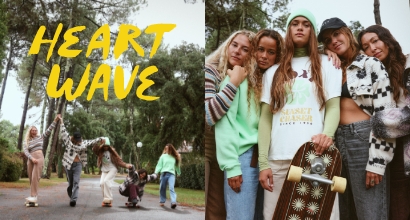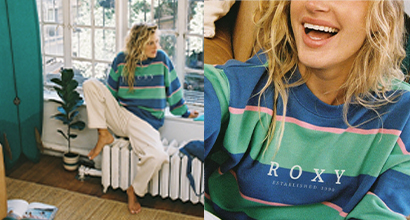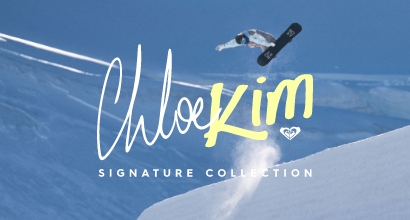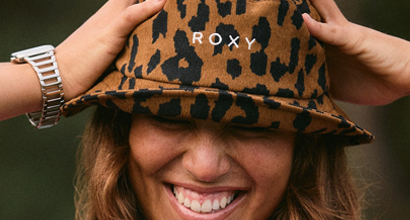-
Login / Register
ROXY GIRL CLUB
Free shipping & returns for members
How To Dress For Skiing: The Essentials
Knowing what to wear skiing can be difficult – there’s a lot of confusing information out there. Written by our in-house experts at Roxy, here’s our comprehensive guide to all the key elements of your skiing outfit, from style to functionality.
Skiing Packing List: The Essentials
Besides skis, you’ll need the following items for a successful day’s skiing.
- Layers. Stay one step ahead of the weather by adding and subtracting clothing layers according to the conditions.
- Outerwear. A waterproof, breathable jacket and pants are vital to staying warm and dry on the mountain.
- Boots. Ski boots are the key link between you and your skis: choose them wisely.
- Gloves. Choose good, ski-specific gloves for warmth, waterproofness and protection.
- Goggles. ski goggles are designed to help you see better, even in harsh winter conditions.
- Helmet. Increase your safety, comfort and confidence with a ski-specific helmet.
What to wear skiing: first time or advanced
With most resorts offering ski, boot and helmet rental, you don’t need to buy a full setup for your first few trips: just rent, borrow or buy the basic essentials until you’re ready to invest in your own kit.
Choosing Ski Layers
Skiing is an intense, physical activity in an environment that can switch rapidly from warm and sunny to cold and wet in a matter of minutes – wearing a good base layer and suitable mid layers is the key to staying warm, dry and comfortable on the mountain. Get your layering right by following these two simple rules.
- Your next-to-skin base layer should be stretchy, snug-fitting and made with a technical, wicking fabric that will transport moisture (sweat) away from your body. Look for technical synthetic fabrics like polyester, or natural merino wool, which are warm, fast drying and breathable.
- Don’t choose a very thick mid-layer between your base and outer layer: instead, take along several thinner mid-layers that can be added or subtracted to match the temperatures. Again, synthetic fabrics or wool are preferable, being better than cotton at wicking moisture away from the body.
Choosing a Ski Jacket
Ski jackets come in a wide variety of shapes, styles and specifications. But to make things simple, here are the two basic types, along with four essential design features to look out for.
- Insulated or Shell: an insulated jacket has built-in insulation that will help you to stay warm and cosy in the typically cold temperatures you’ll experience on the mountain. Meanwhile, an un-insulated shell jacket focuses on waterproofness and breathability.
- Waterproofness and breathability: a ski jacket’s outer fabric has a porous inner membrane that keeps water out while allowing moisture to escape. Most ski jackets (and pants) have a waterproofness/breathability rating that reflects their performance. 5k/5k provides decent entry-level performance, while premium products (like Gore-Tex) are around the 20k/20k mark.
- Essential features: A snow skirt is an elasticated strip of waterproof fabric that wraps around the waist, preventing snow from riding up into the jacket, while Cuff gaiters prevent snow from entering up the sleeves. Under arm vents help to quickly get rid of moisture and excess heat. Last but not least, an adjustable, helmet-compatible hood is perfect for sealing out wind, rain and snow when the weather turns foul.
>> For a more in-depth look at ski jackets, see our how to choose women's ski jackets Expert guide.
Choosing Ski Trousers
Like jackets, ski pants come in both insulated and shell versions, and a broad range of styles, fits and technical specifications. And, as with jackets, the key features to look out for are good venting and ankle gaiters to prevent snow from getting in.
>> For a more in-depth look at ski pants, see our How to choose women’s ski trousers.
Choosing a Ski Helmet
Helmets are fast becoming essential: 80% of skiers and skiers wear a helmet on the snow, whether they are beginners or pros. Here’s a brief checklist of helmet do’s and don’ts.
- DO ensure the helmet conforms to a recognised safety standard, such as the EN 1077.
- DO check the helmet feels secure (but not tight) around your head and the chin strap is secure under your chin.
- DON’T forget to take your goggles along when trying out a new helmet, to ensure compatibility.
- DO look at ventilation and padding to ensure it’s a good match for the temperatures you’ll be mostly riding in.
Choosing Ski Gloves
It’s important to keep your extremities warm on the mountain with a well-made pair of ski-specific gloves. Besides warmth, waterproofness and breathability, durability is vital - skiing is extremely tough on gloves.
Glove or Mitt? Mittens are a lot warmer than gloves, so if you’re skiing in cold temps or just love to feel cosy, get mitts. Gloves give you extra dexterity to adjust goggles, zip-up jackets or, if they are tech-compatible, use your smartphone on the chairlift.
Under or Over Cuff? Under-cuff gloves are shorter and some women prefer the cleaner look, while over-cuff gloves are bulkier, but they are more effective at keeping the snow out on a powder day.
Choosing Ski Goggles
Wind, rain, snow and bright sunlight – the mountains are a harsh environment, so give your eyes the best protection possible with high-quality ski goggles. Look for:
- double lens construction and anti-fog treatment to prevent steaming up
- good optical quality with full UV protection, zero distortion and wide peripheral vision
- Comfortable, even pressure across the face
- Helmet compatibility
- Interchangeable lens systems are great if you ski in all types of conditions
Choosing a Ski Hat
A warm and cosy hat is a must-have on the mountain – even if you wear a helmet while skiing. And while there are a huge variety of styles and materials on offer, you can’t go wrong with a versatile knit beanie that will cover your ears and keep you feeling snug in the snow.
Choosing Neck Warmers & Face Masks
Besides being the perfect way to complete your look, a neck warmer, face mask, hood or balaclava is an absolute life-saver when it comes to protecting your skin from wind, snow and sun. Made with a variety of warm, soft and stretchable fabrics like fleece, acrylic and merino wool, here’s a breakdown of what’s out there.
- Usually made with a tube of fleece fabric, a neck warmer is the simplest, most classic way to keep cold air out of your jacket, and warm air inside it.
- A face mask extends the warmth of a neck warmer to include your lower face and nose.
- A balaclava’s all-over design provides full-face protection and, unlike some face masks, won’t slip down when you’re skiing.
- Ultra-comfortable and versatile, fabric hoods are loose fitting and can be worn in lots of ways – over or under a helmet or beanie, and down as a neck warmer.
Neck warmers, masks and hoods are relatively inexpensive and a fun way to mix up your ski wardrobe, so why not get a few – from a lightweight lycra tube for sunny days, to a fleece-lined hood for deep winter warmth. Get accessorising!
Related Guides
How to Dress for Snowboarding: the Essentials






